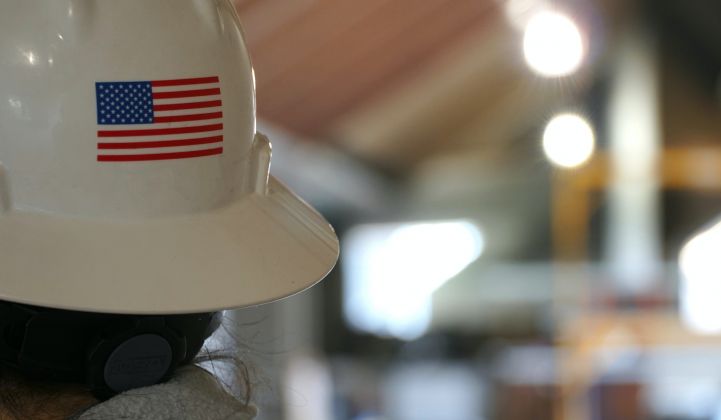What are the most effective ways that national governments can foster energy innovation?
A team of researchers affiliated with the Belfer Center for Science and International Affairs at Harvard University recently published a paper in Nature with some answers.
The authors, led by Gabriel Chan, an assistant professor of science, technology and environmental policy at the University of Minnesota, first identify some positive trends.
In 2016, OECD member countries spent $16.6 billion on energy research, development and demonstration (RD&D), compared with $10 billion in 2000. And there is no shortage of national and global energy initiatives getting launched, such as the Clean Growth Strategy unveiled by the U.K. government in October or Mission Innovation, a clean energy initiative comprising 22 countries and the E.U., launched at COP21 in Paris in 2015.
Even so, “a comprehensive global assessment of energy-innovation programmes is needed to learn from collective experience and to establish best practices,” write the authors.
Based on a review of the scholarly literature as well as third-party assessments of initiatives in the U.K., U.S. and multilateral institutions, the team distilled six guiding principles for energy innovation:
- Give researchers and technical experts autonomy and influence over funding decisions
- Incorporate technology transfer in research organizations
- Focus demonstration projects on learning
- Incentivize international collaboration
- Adopt an adaptive learning strategy
- Keep funding stable and predictable
Let’s look at each of these in turn.
Give researchers and technical experts autonomy and influence over funding decisions
Here, the Belfer Center researchers find much to like at the U.S. Department of Energy. They write that “active scientists are better placed than managers to spot bold but risky opportunities.”
Researchers at DOE’s national laboratories originate projects making up 4 percent of the labs’ budgets. The internally selected projects generate more inventions and patents than projects run out of DOE’s Washington, D.C. headquarters. The authors recommend that public labs that do energy RD&D should dedicate at least 10 percent of their budgets to internally selected projects. They also advise public agencies to mimic the Advanced Research Projects Agency-Energy’s practice of employing technical experts as program managers.
Incorporate technology transfer in research organizations
Here again, the authors praise the DOE, where technology transfer programs at the national labs have enabled researchers to partner with the private sector.
They cite the example of storage for electric vehicles. “Since 1994,” they write, “one-fifth of all new patents in advanced energy systems for vehicles cite at least one DOE-granted patent.” Sandia National Laboratories grants researchers up to three years of leave to commercialize technologies at private companies.
Then-Energy Secretary Ernest Moniz created an Office of Technology Transitions in February 2015 to coordinate the commercial development of department research. DOE also hosts Energy I-Corps, a technology-to-market program that partners national lab researchers with an industry mentor for two-month training sessions.
GTM recently reported on RCAM Technologies, a 3-D printing startup launched by Energy I-Corps graduate and former National Renewable Energy Laboratory researcher Jason Cotrell.
Focus demonstration projects on learning
Policymakers shouldn’t be reluctant to launch demonstration projects -- if a structure is in place to harvest knowledge that can advance new, risky technologies.
The authors advise policymakers to “set goals for demonstration projects on the basis of the knowledge they will generate about the cost and performance of future technologies.” Demonstration projects should also include: “an exit strategy to halt projects that miss milestones; design that acknowledges the possibility of failure while keeping other options open; involvement of a broad pool of private actors; and mechanisms to track and disseminate the knowledge produced.”
Incentivize international collaboration
Despite the myriad benefits that can come with international collaboration -- pooling costs, avoiding duplication, accelerating innovation beyond one country’s capabilities -- such efforts rarely extend beyond meetings or joint statements, the authors lament.
An exception is collaboration facilitated by the U.S.-China Clean Energy Research Center that has enabled U.S. companies to test building energy-efficiency technologies in China. “The pace and scale of construction in China meant that U.S. companies [learned] more about real-world effectiveness than they would have...working only in the United States,” they write.
Adopt an adaptive learning strategy
To measure program performance and change course if necessary, public institutions should establish evaluation mechanisms from the outset, say the authors.
Various metrics can be used to measure outcomes -- money invested, or papers, citations, patents and startups generated -- but whatever benchmark is used, public agencies should store and track such data and make it available to independent researchers.
The International Energy Agency, International Renewable Energy Agency, the World Bank, and other international institutions should be enlisted to help public energy RD&D agencies learn from one another.
Keep funding stable and predictable
In this case, U.S. policymakers have failed. The Obama administration’s stimulus package included $90 billion for clean energy. The Trump administration’s 2018 budget, meanwhile, proposed a 35 percent cut in funding for energy RD&D.
What do such wild swings mean in practice? “Between 1990 and 2017,” the authors note, “U.S. political shifts meant that each year, on average, one in five DOE technology areas saw a budget increase or decrease of greater than 30%.”
The researchers advise policymakers to resist the temptation to reflexively launch new energy innovation programs. In the U.S. context especially, political swings represent an ever-present threat. Will funding for a favored program survive from one election to the next?
“Rather than overhauling institutions for energy innovation with different political cycles, existing programmes should be continuously evaluated and updated. New programmes should be set up only if they fill needs that are not currently met,” the authors conclude.




